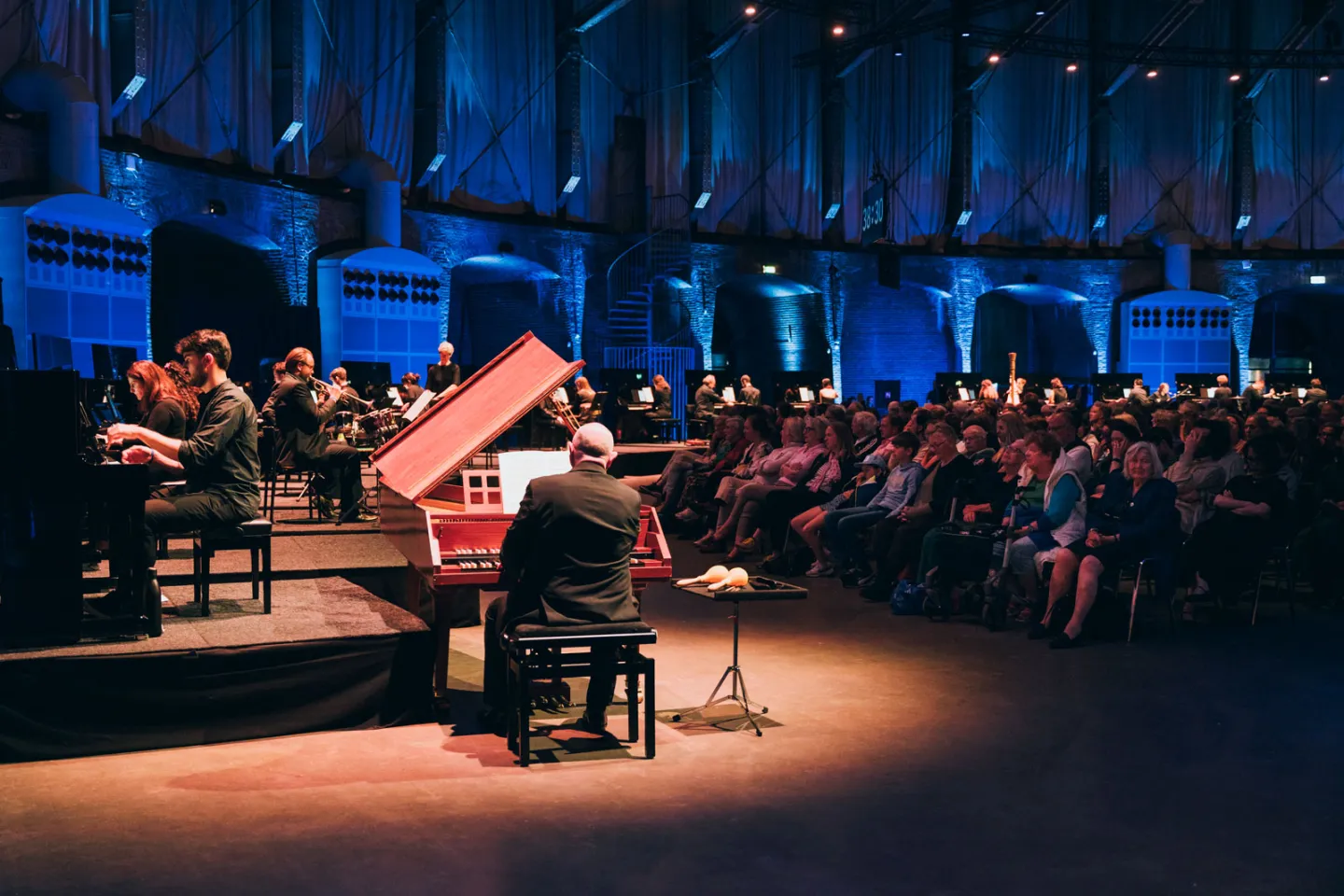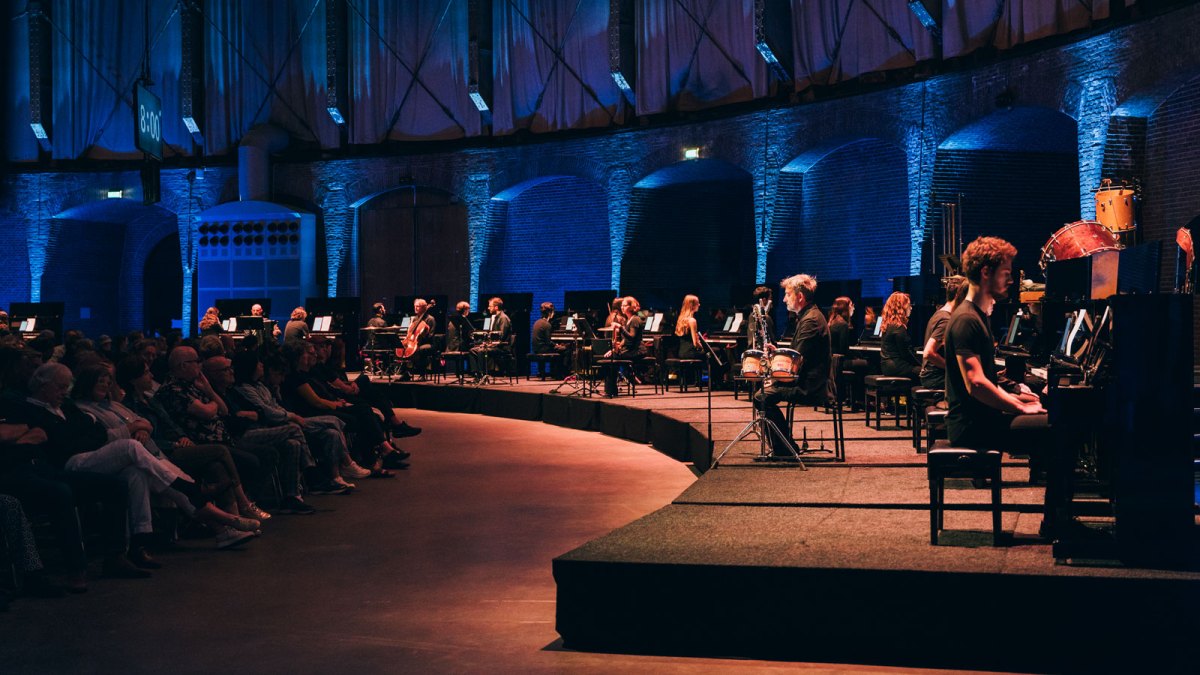Putting 50 pianos in a room creates a sense of occasion. On Saturday, I heard Georg Friedrich Haas’s “11.000 Saiten” (“11,000 Strings”), for 50 uprights tuned in ascending intervals of two cents and the contemporary music ensemble Klangforum Wien, at the Holland Festival in Amsterdam. Although the piece premiered in August 2023 in Bolzano, Italy, and has since been performed at the Wien Modern and Prague Spring festivals, the pre-concert excitement was palpable. Many people arrived early to secure good seats, and strangers chatted as they waited for the performance to start. They seemed jolted out of new-music-concert somnolence by such blunt, physical proof of raw ambition: the gigantic Gashouder was full of instruments. That “11.000 Saiten” didn’t actually get going until the second attempt was a sign of its choreographic difficulties, but also a reminder that enormous energies must be released carefully.
“11.000 Saiten” opened with surprising mildness given the intensity of the visual impression: The music began with a bookend C major chord, roughly mezzo-piano, in the harpsichord, harp, celesta, and vibraphone. When the 50 pianos first entered, marked pianissimo and playing compact figures in a low range, I didn’t hear them: The ensemble, whose constant swells ranged up to fortissimo by then, was creating a thunderous harmony. When this outer crust melted away, it revealed all the pianos playing a chromatic scale, their individual intervallic relationships to one another so small many people only register them as a shift in color. (All together, the effect is awe-inspiring.)

At least that’s what my eyes told me later, looking at Haas’s score. (Full disclosure, I studied composition with Haas between 2011 and 2013.) What I heard is much harder to describe, because for the first time in a very long time I was experiencing a sound actually unlike any I knew. Then a very high, soft, sustained G-sharp in the violin, a sudden, fortissimo bass drum tremolo that activated my amygdala and therefore in just two beats a state of heightened concentration, and we were in the thick of the 65-minute work.
50 pianos tuned in intervals of two cents evokes the cacophony I’d imagine you perceive as a worker bee in the depths of the hive, fulfilling your servitude with the weight and certainty of (roughly) 120 million years of evolution. 50 pianos tuned in intervals of two cents feels like being one of the human ear’s 3,500 inner hair cells, one miniscule part of a complex conduit from vibration to electric signal. Experiencing “11.000 Saiten” must be something like being placed inside a particle collider. You felt like you could reach out and touch the quarks. At times it seemed as if the sonic energy of the piece was coalescing in the very middle of the Gashouder, where no one was sitting, and that this energy could at any moment blow the roof of the space right off.
The spatialization, or placement of instruments in the room, for “11.000 Saiten” is as essential to its effect as the piano tuning. (In the score, Haas suggests the instruments be placed in a circle, but they can also take the form of an ellipse or an octagon.) There’s an undeniable eroticism to a sound that hits the hairs on the back of your neck on its way to your ears. Especially when that sound is 50 pianos tuned two cents apart playing major and minor chords and entering at stochastic intervals.
The composer Helmut Lachenmann once defined beauty as “Verweigerung von Gewohnheit,” a “refusal of habit.” “11.000 Saiten” contained so many sounds that were new to me that when, at one point, I picked out a percussionist bowing a cymbal—a familiar new music gesture—it felt like a pleasingly anachronistic reminder of the present, the sandy Coke can at the pyramids.
The climax of “11.000 Saiten” involves a sound as foreign and as terrifying as I can remember: All the pianos playing fast glissandi up and down their keyboards, alternating with palm clusters, a texture punctured but not deflated by tubular bells. When the piece ended, I felt a deep exhaustion. Listening to a new piece of music is a little like that kindergarten game where you feel an object inside an opaque box; in this version, the object just happened to be not a Slinky or a stress ball but something no one had ever touched before. Walking, zombie-like, outside the hall, my ears rang and my body crumpled. I had been sitting for 65 minutes, but I still needed to find a seat.
The latest from VAN, delivered straight to your inbox
With a shot of vodka, a cigarette, and a 20-minute nap, I would have been ready to hear the whole thing again.
By virtue of the effort involved in its piano casting, moving and tuning, Haas’s piece belongs to a lineage of works that could be called the heroically impractical. In 1844, Hector Berlioz put on a concert with two orchestras and choir numbering 863 participants. In 1899, Augusta Holmès premiered her “Ode triomphale” for a 300-piece orchestra and 11 choirs. Bernd Alois Zimmermann’s “Die Soldaten” (1965) originally had seven “tempo layers” and required seven conductors; Horațiu Rădulescu’s “Dr. Kai Hong’s Diamond Mountain” (1991) is scored for 61 spectral gongs and soloists. One aspect of beauty as a refusal of habit is the rejection of habitual music-industry pragmatism—a habit that seems everywhere these days, perhaps related to our climate of austerity and political insecurity and the desire of some conductors to learn the brand-new score within the duration of a first-class flight.
The heroically impractical lineage in music has (naturally) massive resonance for the place of art in our lives as a whole. These works amplify the glorious contradictions of art’s senselessness; they are essential to the way it lets us discover without colonizing. Listening to “11.000 Saiten” felt like taking steps on the moon, except this moon had sprung from the mind of another person. I hope I get to hear it again. ¶
Subscribers keep VAN running!
VAN is proud to be an independent classical music magazine thanks to our subscribers. For just over 10 cents a day, you can enjoy unlimited access to over 875 articles in our archives—and get new ones delivered straight to your inbox each week.
Not ready to commit to a full year?
You can test-drive VAN for one month for the price of a coffee.



